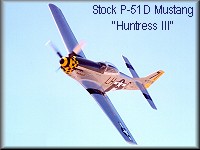 In his 1992 "The Last Piston
Show" written for
Air And Space Magazine, Larry Lowe wrote: "Unlimited-class
air racing is slowly dying" ..... "talk
is of what will happen on the Day They Break the Last
Merlin" ..... "Ironically,
in the very act of preserving the essence of the kind of
aviation that the Merlin represents, the racers are
helping to condemn it to extinction." ... It's now 1998 and there's good
news... Unlimited Air Racing has not died.....Even better
news, it just might be gaining a new lease on life! In his 1992 "The Last Piston
Show" written for
Air And Space Magazine, Larry Lowe wrote: "Unlimited-class
air racing is slowly dying" ..... "talk
is of what will happen on the Day They Break the Last
Merlin" ..... "Ironically,
in the very act of preserving the essence of the kind of
aviation that the Merlin represents, the racers are
helping to condemn it to extinction." ... It's now 1998 and there's good
news... Unlimited Air Racing has not died.....Even better
news, it just might be gaining a new lease on life! Unlimited Air Racing is unquestionably the
worlds fastest motorsport, the fastest of the fast race
in the Gold-Class, where top speeds can exceed 500-MPH.
From its re-birth in 1964, Championship Air Racing's
winning entries have most often been World War Two
aircraft, specially modified for the extremely high
speed, low altitude racing. Supplies of the superbly
powerful vintage fighters were plentiful and prices
affordable enough to assure a steady flow of new entries
to the sport. Sadly, things are different now, Strega
Crew Chief, Bill Kerchenfaut tells us; "The day
of the inexpensive fighter plane is over"...."When air
racing was revived in '64, you could buy a P-51 Mustang
for $5000."...."One of the problems we
have today with the world war two aircraft is that, there
aren't any parts available. The parts that are available
are just astronomically expensive....if you can find
them!" Unlimited Air Racing is unquestionably the
worlds fastest motorsport, the fastest of the fast race
in the Gold-Class, where top speeds can exceed 500-MPH.
From its re-birth in 1964, Championship Air Racing's
winning entries have most often been World War Two
aircraft, specially modified for the extremely high
speed, low altitude racing. Supplies of the superbly
powerful vintage fighters were plentiful and prices
affordable enough to assure a steady flow of new entries
to the sport. Sadly, things are different now, Strega
Crew Chief, Bill Kerchenfaut tells us; "The day
of the inexpensive fighter plane is over"...."When air
racing was revived in '64, you could buy a P-51 Mustang
for $5000."...."One of the problems we
have today with the world war two aircraft is that, there
aren't any parts available. The parts that are available
are just astronomically expensive....if you can find
them!"
 Over the last decade many of these aircraft
have become so rare and valuable in their original form
that several former race planes have been returned to
stock configuration, bringing some to conclude the sport
might well be doomed. Indeed, the era of new
entries from radically chopped and modified W.W.II piston
engined fighters is probably gone. Take, for
example, the most seen and recognized aircraft on the
Reno circuit, the P-51 Mustang. Today, a stock P-51D can
fetch a price of $750,000 on the market. The TF-51
(two-place P-51D set up with dual controls for training)
commands a price tag of about $1.2 million. It is easy to
see that economics and availability now dictate the
decline of new racers coming from this formerly plentiful
source. Over the last decade many of these aircraft
have become so rare and valuable in their original form
that several former race planes have been returned to
stock configuration, bringing some to conclude the sport
might well be doomed. Indeed, the era of new
entries from radically chopped and modified W.W.II piston
engined fighters is probably gone. Take, for
example, the most seen and recognized aircraft on the
Reno circuit, the P-51 Mustang. Today, a stock P-51D can
fetch a price of $750,000 on the market. The TF-51
(two-place P-51D set up with dual controls for training)
commands a price tag of about $1.2 million. It is easy to
see that economics and availability now dictate the
decline of new racers coming from this formerly plentiful
source.
 Worried someday there will be no classics
raced at Reno? Fear not.... There will probably always be
stock or near stock warbirds raced at Reno, but few Gold-Class
races will be won by stock warbird airframes.
Modification and innovation will always be needed to
break into the speed territory Gold-Class
aircraft occupy. The very modifications that,
unfortunately, lower the ever raising value of the
increasingly rare airplanes. The question becomes: Where
are we going in this sport? Worried someday there will be no classics
raced at Reno? Fear not.... There will probably always be
stock or near stock warbirds raced at Reno, but few Gold-Class
races will be won by stock warbird airframes.
Modification and innovation will always be needed to
break into the speed territory Gold-Class
aircraft occupy. The very modifications that,
unfortunately, lower the ever raising value of the
increasingly rare airplanes. The question becomes: Where
are we going in this sport? 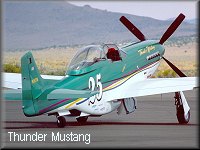 Where will the future winning aircraft come
from? It has been suggested, by some very well
placed players in this game, that the sport as we know it
has but a few years left in it, that a new
"unlimited" class will be born within limits on
engine size. Others feel that if the racing is not done
in a form close that of the present, the sport would
indeed die.... Again the question: Where are we going in
this sport? Where will the future winning aircraft come
from? It has been suggested, by some very well
placed players in this game, that the sport as we know it
has but a few years left in it, that a new
"unlimited" class will be born within limits on
engine size. Others feel that if the racing is not done
in a form close that of the present, the sport would
indeed die.... Again the question: Where are we going in
this sport?
 One entry has adopted an approach some feel
could be the wave of the future. The Thunder Mustang made
its debut at Reno'97. This 3/4 scale P-51D replica is
fabricated entirely from carbon fiber composites and
aluminum, weighing in at 1/4 the mass of the W.W.II
fighter. Even with its normally aspirated Ryan Falconer
V-12, 600 HP engine, the power to weight ratio is
significantly better than its contemporaries. (best
thing about it, even YOU can own one of these birds for
the meager sum of $195,000-including engine). With
engine mods to boost performance to approximately 1000 HP
planned for this year's event, this aircraft may prove a
viable Unlimited entry, if not become the model for a
future racing series. Although a crowd favorite last
year, the Thunder Mustang, even with its new
engine, will probably fall short of being a serious
contender for top honors in the Gold-Class. This
will remain the realm of the "heavy metal"
entries for the foreseeable future. One entry has adopted an approach some feel
could be the wave of the future. The Thunder Mustang made
its debut at Reno'97. This 3/4 scale P-51D replica is
fabricated entirely from carbon fiber composites and
aluminum, weighing in at 1/4 the mass of the W.W.II
fighter. Even with its normally aspirated Ryan Falconer
V-12, 600 HP engine, the power to weight ratio is
significantly better than its contemporaries. (best
thing about it, even YOU can own one of these birds for
the meager sum of $195,000-including engine). With
engine mods to boost performance to approximately 1000 HP
planned for this year's event, this aircraft may prove a
viable Unlimited entry, if not become the model for a
future racing series. Although a crowd favorite last
year, the Thunder Mustang, even with its new
engine, will probably fall short of being a serious
contender for top honors in the Gold-Class. This
will remain the realm of the "heavy metal"
entries for the foreseeable future.
 Over the years there have been efforts to
bring other completely new racers to the high desert
pylons to mix it up with the "big boys on the
block". The Pond Racer went in the Over the years there have been efforts to
bring other completely new racers to the high desert
pylons to mix it up with the "big boys on the
block". The Pond Racer went in the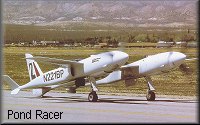 most radical direction ever seen, totally
departing from the known, stepping into the uncharted
region of using highly modified automobile racing engines
in a radical airframe. Unfortunately the results ended
tragically for this promising effort before its potential
could be completely evaluated. Tsunami (lost in
a non-racing accident) went at it with a sleek custom
airframe powered by a highly modified Rolls Royce Merlin
powerplant. This design not only proved most radical direction ever seen, totally
departing from the known, stepping into the uncharted
region of using highly modified automobile racing engines
in a radical airframe. Unfortunately the results ended
tragically for this promising effort before its potential
could be completely evaluated. Tsunami (lost in
a non-racing accident) went at it with a sleek custom
airframe powered by a highly modified Rolls Royce Merlin
powerplant. This design not only proved 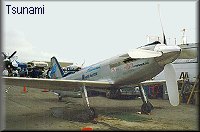 that it could run with the best of them, it
proved to be a Gold winner! Now some 6 years later, we
are starting to see some of the effects of John
Sandberg's contributions to innovative design. Taking
from the known, adding in the new, and applying it in a
pragmatic approach can yield winning results. This
approach seems to have met with favor among the racing
fraternity, as current and future projects are tending to
adopt this winning formula. Alternative design solutions
are viable and cost effective as well as just plain good
looking, some of the projects in the works are
wonderfully so. that it could run with the best of them, it
proved to be a Gold winner! Now some 6 years later, we
are starting to see some of the effects of John
Sandberg's contributions to innovative design. Taking
from the known, adding in the new, and applying it in a
pragmatic approach can yield winning results. This
approach seems to have met with favor among the racing
fraternity, as current and future projects are tending to
adopt this winning formula. Alternative design solutions
are viable and cost effective as well as just plain good
looking, some of the projects in the works are
wonderfully so.
|


 In his 1992 "The Last Piston
Show" written for
Air And Space Magazine, Larry Lowe wrote: "Unlimited-class
air racing is slowly dying" ..... "talk
is of what will happen on the Day They Break the Last
Merlin" ..... "Ironically,
in the very act of preserving the essence of the kind of
aviation that the Merlin represents, the racers are
helping to condemn it to extinction." ... It's now 1998 and there's good
news... Unlimited Air Racing has not died.....Even better
news, it just might be gaining a new lease on life!
In his 1992 "The Last Piston
Show" written for
Air And Space Magazine, Larry Lowe wrote: "Unlimited-class
air racing is slowly dying" ..... "talk
is of what will happen on the Day They Break the Last
Merlin" ..... "Ironically,
in the very act of preserving the essence of the kind of
aviation that the Merlin represents, the racers are
helping to condemn it to extinction." ... It's now 1998 and there's good
news... Unlimited Air Racing has not died.....Even better
news, it just might be gaining a new lease on life!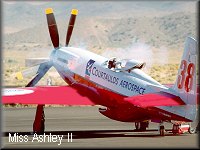 "What we're doing is a workable
alternative" says designer/builder Bill Rogers.
Last year saw the introduction of the Levitz/Rogers Miss
Ashley II to the Reno Unlimited Class. Known by many
as a "Learstang", the airplane is a less
radical departure, basically a hand-built Mustang
fuselage, mated to the very sleek Lear Model 23 wing and
tail. Powering this entry is the much less rare [than the
Merlin] and much larger Rolls Royce Griffon engine.
"What we're doing is a workable
alternative" says designer/builder Bill Rogers.
Last year saw the introduction of the Levitz/Rogers Miss
Ashley II to the Reno Unlimited Class. Known by many
as a "Learstang", the airplane is a less
radical departure, basically a hand-built Mustang
fuselage, mated to the very sleek Lear Model 23 wing and
tail. Powering this entry is the much less rare [than the
Merlin] and much larger Rolls Royce Griffon engine.